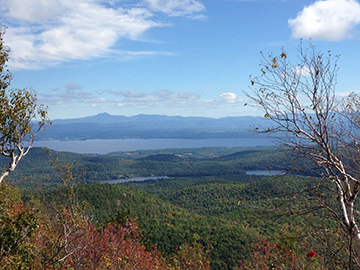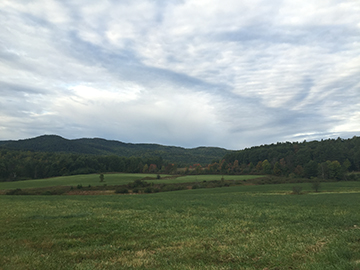
Will This Summer's Drought Impact Adirondack Fall Foliage?

By: Mary Godnick – Marketing and Development Assistant
September 30, 2016
This summer along with the rest of the Northeast, the Adirondack Park has experienced a record-breaking dry season. Rivers, lakes and streams were unusually low, and farms and gardens required extra sources of water. With precipitation below average for most of the summer months, this has many of us wondering, what will this shortage of rainfall do to our usually vibrant fall foliage? In short, it could go either way.
Leaves turn colors because of the trees food-making process, called photosynthesis. During photosynthesis, trees take water up through their roots and carbon dioxide from the air. They turn water and carbon dioxide into oxygen and glucose with the use of sunlight. The glucose then acts as food, and the oxygen is expelled as "waste."
 Chlorophyll is critical to the photosynthetic process because it allows sunlight to be used as energy. It is also what makes leaves green, hiding the yellow and orange pigments for most of the year. When daylight and temperature changes occur in the fall, photosynthesis stops and the chlorophyll slowly breaks down. The green color disappears and the yellow, orange and red colors become more visible, giving us the magnificent palette of colors that we enjoy so much during the fall.
Chlorophyll is critical to the photosynthetic process because it allows sunlight to be used as energy. It is also what makes leaves green, hiding the yellow and orange pigments for most of the year. When daylight and temperature changes occur in the fall, photosynthesis stops and the chlorophyll slowly breaks down. The green color disappears and the yellow, orange and red colors become more visible, giving us the magnificent palette of colors that we enjoy so much during the fall.
The three main factors that influence the timing of trees turning colors and loosing their leaves are the length of days, temperature and available water. Dry conditions could limit photosynthesis, thus producing less sugar. The lower sugar amounts could result in less vibrant colored leaves. Leaves may start to brown and "crisp" at the edges, and just fall off.
A drought can also cause leaves to turn colors weeks earlier than usual, shortening the "leaf peeping" season. According to Curt Stager, Professor at Paul Smith's College Department of Natural Sciences, "Dry conditions in summer can stress the trees and make them turn color earlier, so it can make the colors less vivid at the peak of the season."
In some areas, colors are starting to turn. The New York State Fall Foliage Report shows that throughout the Adirondacks, the colors are just changing, whereas the outskirts of the state have not seen any changes yet. The foliage will look very different from area to area based on elevation, temperature and types of trees.
Don Leopold, Botany professor at SUNY ESF says, "Most of Upstate New York may see some early turning for sugar maple tree leaves and trees planted in urban settings, while the native forests of New York will more or less be normal, give or take a week overall."

Others predict a similar outcome. Colin Beier, Associate Professor at SUNY ESF Department of Forests and Natural Resources Management says that, "A few species might be duller, others may be brighter. I expect Adirondack wetlands will have blazing red maples and radiant tamaracks within a week or two."
But the foliage is also triggered by temperature fluctuations. Beier says that, "The cool nights we've had recently are quite important to trigger the plant's entrance into dormancy, which includes breaking down pigments and recycling their nutrients back into storage for the winter. That's what creates the colors we see - so colors have been delayed up in the north country... but should be hitting stride very soon."
But no one is really sure what will happen. He says, "If trees were stressed by drought conditions this summer, then perhaps colors might appear duller... but they also might appear brighter because the plant is compensating for some loss it suffered during the year. It's not clear either way. "
Overall, the experts agree, we will have to just wait and see what happens. If you're planning a trip to the region and want to make sure that you hit the foliage "peak," you may want to follow along some of the "fall foliage reports" such as the Adirondack Mountain Club is doing from Heart Lake on Facebook. Stager notes that our "best bet is to wait and see; even a relatively modest autumn display here in the Adirondacks is still beautiful."
|
|||





